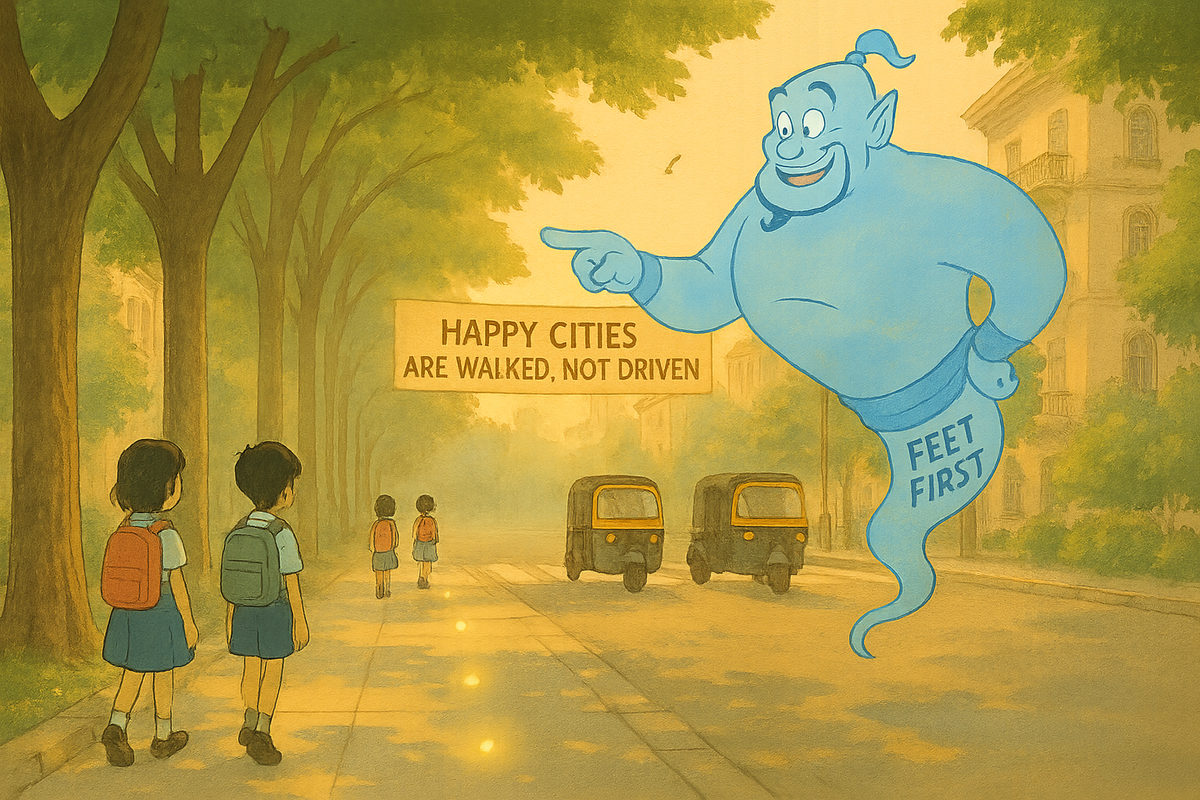Urban Walkability: Can We Design Cities That Invite You to Walk?
Discover how walkable cities improve health, safety, economy & joy. Learn what Indian cities must do to reclaim sidewalks and design for pedestrians.

Discover how walkable cities improve health, safety, economy & joy. Learn what Indian cities must do to reclaim sidewalks and design for pedestrians.
🧞♂️ Hello again, ground explorers! I’ve seen cities from above and from below. And I can tell you this: the happiest places aren’t driven — they’re walked. Let’s rediscover what makes a city truly liveable, one step at a time.
1. Introduction: The Forgotten Foundation of Urban Life
Before flyovers and traffic lights, there were feet. Streets weren’t just conduits for cars — they were community spaces, markets, and playgrounds. But in today’s car-centric cities, walkability has become an afterthought.
India’s metros are among the least walk-friendly in the world. Broken footpaths, unsafe crossings, and encroachments make even short walks stressful — if not dangerous. And yet, 30–40% of urban trips in India are still made on foot.
Designing for pedestrians isn't a luxury — it's an urban necessity.
2. Why Indian Cities Fail Walkers
The pedestrian experience in most Indian cities is fragmented at best. Even where sidewalks exist, they are often unusable. Here’s why walking is so hard:
- Encroachments: Footpaths blocked by stalls, parked bikes, and garbage bins
- Gaps & Discontinuity: Frequent breaks force walkers onto the road
- Heat & Dust: Lack of shaded pathways or dust control makes walking unpleasant
- Safety Concerns: Poor lighting and unguarded lanes raise the risk of theft or assault
- Signal Neglect: Short walk times at crossings, if any signals exist at all
As a result, walking becomes a last resort — not a default mode.
3. The Benefits of Walkable Cities
Investing in walkability isn’t just about footpaths — it’s about returns. Here’s what walk-friendly cities gain:
- Health: More walking means lower obesity, diabetes, and cardiovascular risks
- Environment: Reduced emissions and noise pollution from fewer short car trips
- Local Economy: Pedestrian traffic boosts neighborhood retail and cafes
- Social Cohesion: Streets become safer and friendlier when people walk and interact
According to a World Bank report, a well-designed walking network can raise property values by 5–15% and reduce citywide emissions by up to 10%.
Walking isn’t just healthy — it’s contagious. When a city makes it easy to walk, more people follow.
4. Global Examples India Can Learn From
Several cities around the world have transformed into pedestrian paradises — proving that walkability is a choice, not just a luxury.
- Copenhagen, Denmark: Over 80% of people walk or cycle daily. Their “5-minute city” approach ensures that essential services are accessible within a short walk.
- Bogotá, Colombia: The “Ciclovía” program shuts down main roads on Sundays to cars, turning them into public walking and cycling spaces.
- Singapore: Combines shaded walkways, elevated paths, and pedestrian-priority traffic signals to make walking comfortable year-round.
These cities didn’t start perfect. They invested slowly but consistently — and today, the footpath is the city’s social spine.
India has the numbers. We now need the will.
5. What Needs to Change at the Policy Level
India’s Smart Cities Mission includes pedestrian improvements, but the implementation varies. Here’s what policies can do better:
- Dedicated pedestrian zones: Car-free streets in commercial and heritage areas
- Urban zoning reforms: Mixed-use zones reduce trip distances
- Footpath-first budgets: Set aside specific allocations for pedestrian infrastructure
- Clear width standards: Minimum 1.8–2.5 meters for footpaths in dense zones
- Enforcement of encroachment laws: Regular audits and civic partnerships
Smart cities aren’t just digitally connected — they’re physically walkable.
6. Conclusion: Build Streets for Feet First
Walkability is more than a checkbox. It’s the baseline for an inclusive, healthy, and vibrant city. A place where children, elders, and everyone in between can move freely and safely.
As your walker-in-chief, the Genie says this: give space to the feet, and the city will follow. Because no one falls in love with a city from behind a windshield — but many do from the sidewalk.
Every happy city begins with a good walk.
Keyword: urban walkability India, pedestrian infrastructure India, walkable city design, footpath encroachment India, smart cities walking, sidewalk policy India, pedestrian crossings India, urban design for walkers, car-free zones India, walk-first urban planning, mobility and livability India, pedestrian safety features, urban zoning reforms India, SpotGenie Gyaan, how to fix Indian footpaths
Follow us on:
🅾 Instagram |
ⓕ Facebook |
𝕏 X |
▶️ YouTube |
🟢 WhatsApp
🚶♂️ More SpotGenie Gyaan on Building People-First Cities
- The Problem With Jaywalking – Prioritizing Pedestrian Safety in India
- How Citizens Can Help Decongest India’s Streets – One Step at a Time
- The Hidden Cost of Road Rage – Emotion, Accidents, and Urban Chaos
- Urban Parking 101 – What’s Legal and What’s Not on Indian Roads
- Get SpotGenie – Smart QR Sticker to Improve Civic Communication on Streets
Sidewalks are the soul of cities. SpotGenie helps spark awareness and accountability—because great cities are walked, not driven through.



